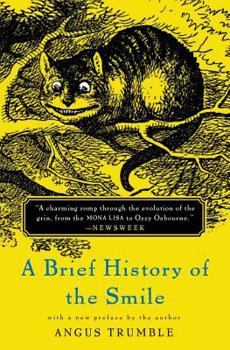A Brief History of the Smile
Select Format
Select Condition 
Book Overview
Every smile is the product of physical processes common to all humans. But since the dawn of civilization, the upward movement of the muscles of the face has carried a bewildering range of meanings. Supreme enlightenment is reflected in the holy smile of the Buddha, yet the Victorians thought of open-mouthed smiling as obscene, and nineteenth-century English and American slang equated "smiling" with drinking whisky.In A Brief History of the Smile,...
Format:Paperback
Language:English
ISBN:0465087795
ISBN13:9780465087792
Release Date:February 2005
Publisher:Basic Books
Length:226 Pages
Weight:0.70 lbs.
Dimensions:0.7" x 5.3" x 8.1"
Customer Reviews
4 ratings
Amusing,Very Interesting SMILE History!
Published by Thriftbooks.com User , 19 years ago
Mr. Trumble is an art historian with a terrific wry sense of humor, and great knowledge about his subject! His talk to some dentists led him to research the long and mostly amusing history of the smile. Analyzing Greek,Chinese, Cambodian sculptures, some of the best known western SMILE paintings,Japanese geishas (who dyed their teeth black), early US Presidents (a bit dour until the advent of Teddy Roosevelt),Darwin's thoughts on the facial habits of his new-born babes, and a lot more, we are led through a smiling tour de force. This is the kind of book you'll read closely the first time, and then probably browse thru for interesting and amusing tidbits.So why not click the order button right now!
A warm, engaging and delightful little book
Published by Thriftbooks.com User , 19 years ago
This book was really a lot of fun to read. Angus Trumble is obviously a very knowledgeable expert in the field of art history (and it appears a lot of other things), but he brings a wit and whimsy to the subject that really transforms the material and makes art a delightful experience. I enjoyed every minute of it.
A Happy History
Published by Thriftbooks.com User , 19 years ago
Say "cheese." If you say cheese, you are ready for the photographer to render a picture-perfect portrait complete with smile. That's the way it has been since around 1920, when photographers at British public schools developed the tradition. And yet that is not the way it has always been, according to _A Brief History of the Smile_ (Basic Books) by Angus Trumble, a lively history of a subject no one might expect to have a history. The photographer Cecil Beaton instructed his subjects to say "lesbian." In Australia there is a fashion for saying "money." Spaniards say "patata" (potato) and the Japanese use the English word "whisky." The Czechs used to use the Czech word for cheese, but now say "fax" which may hurtle them into modernity. Plenty of languages don't have a smile word; the photographers just ask for a smile and the subjects do the best they can. We don't smile just for the photographer, of course, and Trumble, a museum art curator, has a lot more to say about his subject, a pleasant history that he happily says is "about smiling in the broadest possible sense." The origin of this book was a surprise invitation to Trumble to address a convention of dentists. As a curator of art, he was thought by the dentists to have something to say on the representation of teeth and beauty. He began to examine smiles in art. You can bet the _Mona Lisa_ is here, as is Frans Hals's _Laughing Cavalier_. There is a famous "archaic smile" on early Greek sculpture. The figures of young men and women stand stiffly, but their mysterious smiles give them a reassuring amount of life. Dutch and Flemish painters of the 17th century had a favorite subject of the "hennetaster," or "chicken groper," a boy who smiles as he feels up a hen to see if she has an egg on the way. These enormously popular paintings were riotously funny to their owners and the guests to whom they were displayed; the humor in part derived from the interchangeability of the Dutch words for bird, birds, or hens with those for genitalia, women, coitus, and other double entendres. The mysterious figure of the sheela incongruously may be found in Irish churches; she grins as she displays her genitals. This image distressed art historians, one of whom depicted the sheela simply with her hands on her hips. The figure is not like a repulsive gargoyle, however, and harks back to the magical women who would, for a fee, lift their skirts and show their genitals as a way of granting good luck. Jesus smiles as he undergoes crucifixion in an abbey in Eichstatt, and some of the Romanesque sculptures, which otherwise have very small mouths, are brightened by surprising smiles. This is a charming miscellany. Here you will be able to find a little bit about gurning, not grinning, which is an extreme form of making faces, in competition, no less. Lipstick sales go up when economics go down. Geishas stained their teeth black to set them off against faces painted dead-white. The nerves t
it made me smile
Published by Thriftbooks.com User , 20 years ago
I loved this book. It was full of useless information (the most fascinating kind) and was obviously a labour of love. I never knew about sheelas. (I always thought they were middle aged Australian barmaids.) The fact that this book is so engaging, so resolutely cheerful, and written with such a sustained lightness of touch is all the more surprising since it was written by a Trumble. (Trumbles being, in my experience at any rate, genetically predisposed towards gloominess, and not given overmuch to smiling.) Maybe it will be left to another, more upbeat family to compose "A Brief History of the Frown".




